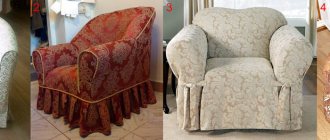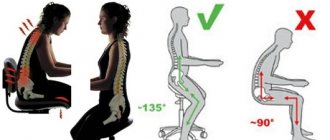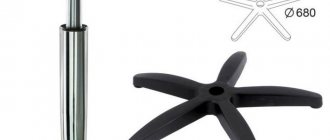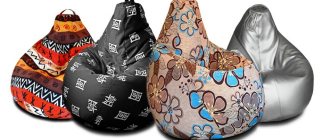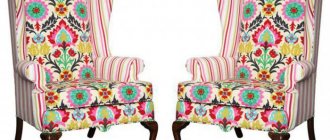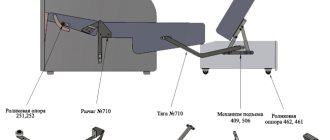Main features of restoring an old chair
The process of restoring damaged furniture is not a partial restoration of parts or replacement of upholstery, it is giving a new look to an old chair, an opportunity to refresh it. Rework is carried out when the legs are wobbly, the upholstery is worn out, springs are sticking out, or the structure is loose.
The peculiarity of the restoration process is that it is quite difficult to do it yourself, so this matter is entrusted to professionals.
You can partially remake and restore upholstered furniture yourself:
- dismantle the upholstery;
- make a constriction;
- legs are repaired or replaced.
It’s worth trying to restore furniture with your own hands if you have enough experience in furniture repair or if you don’t have enough money for quality materials.
The only downside to restoration is the lack of professionalism in restoration work.
Advantages of restoration at home:
- cost savings;
- the value of the interior item increases;
- the interior is refreshed.
Office chair repair
Organizations often send chairs for repair. Reupholstering is a simple task, but when the amount of work is large, only professionals can handle it quickly and efficiently. They can come to your office or home, take measurements for free and calculate the exact cost of the work. Also pick up products for repair and bring them back at the appointed time. Often the entire work takes no more than 2-3 days.
Not only upholstery replacement is included in the work of such companies. They can repair the chair frame itself, replace casters and legs, foam rubber and plywood. The cost of the service will depend on the volume and urgency of the work performed. The calculation is based on what parts were used and how much time was spent.
Required materials and tools
First you need to select a set of tools and materials.
You can use a standard set of tools, and a set of brushes and paints for a painter. Unavailable tools are purchased according to the recommendations of the master, so as not to damage the parts during work. Pure wood furniture is sensitive to floors and can dry out.
Required materials and tools:
- chisel, spatula;
- hammer, screwdriver;
- stationery knife, wood glue;
- set of brushes, roller;
- acrylic paints, water-repellent varnish;
- sanding machine, foam rubber;
- stapler, sandpaper, new springs;
- screwdriver, awl, large needles with silk threads.
Repair features
The design of the chair and its material are determined by what it is intended for. This could be the chair of a boss or management team, or an ordinary employee or client. The status of the chair is indicated by its upholstery. Often this is a leather option. Others have cheaper analogues or a textile surface - they are lighter in design and mobile.
When the owner is already very fond of the chair, it is not necessary to buy a new one and get used to it. You can order upholstery of old furniture or do it yourself if your skills, materials and tools allow.
Main types of modifications and materials
The restoration of upholstered furniture, like the restoration of an antique chest of drawers, is divided into types that can be combined.
Padding
This method does not affect the restoration of the frame. This is where the upholstery fabric is reupholstered. It is either attached to an old covering, which is not recommended by craftsmen, but it makes the chair look voluminous. Or they change the coating along with the filler.
High-quality and durable fabrics:
- velor, corduroy;
- eco-leather, jacquard;
- flock, tapestry;
- microfiber, chenille.
A thick crinoline is suitable for the inner lining of the filling. The density and elasticity of the material will not allow foam rubber and springs to dig into the upper upholstery.
The constriction is done like this:
- disassemble
the chair, even if it has wooden arms or a back;
- unscrew the bolts
that fasten the legs to the frame; - remove the armrests, disassemble the bottom;
- remove the upholstery
from the seat, armrests, backrest; - the old upholstery is applied to the new fabric, the parts are cut out according to exact parameters;
- foam rubber is cut according to the parameters of the bottom with an addition of 2-3 cm;
- springs are attached to the bottom, then the filler, and the structure is secured with internal upholstery;
- the armrests are covered with foam rubber and inner fabric
, the backrest is restored like its bottom; - the details of the cross are attached to the frame and sheathed with outer fabric
.
Re-upholstery is done for the soft version. Furniture with wooden parts is subject to complete repair.
Upholstery
Restoration method for a chair with a rigid base. In appearance, the furniture has clear geometric lines, upholstered in thick fabric with thick foam inside.
To restore you need:
- remove the top covering fabric;
- remove the filler and its fastenings;
- new parts are cut out from old parts;
- the structure is checked for looseness, the damaged frame is replaced or restored;
- The filler is stapled onto the new base, then the upper upholstery.
This restoration method is suitable for chairs with a solid wooden base.
Repair
General view of the restoration work. Combines the process of upholstery, reupholstery and complete replacement of the base. The structure is checked for damage, the legs are replaced, and a metal fastener is added for strength.
Restore the surface using paints, varnishes, and additional tools. This method of restoration is quite complicated; the chair is given to craftsmen to work on.
Chair back restoration
We will separately consider repairing the backrest if it was broken for any reason. After completely dismantling the upholstery, you need to determine the cause of the breakdown. These could be loose fastening bolts that need to be tightened.
- If there is a crack in the frame, you can try to find a similar part and replace the broken one. Or carve a new one out of wood yourself.
- If the cause of the breakdown is a loose tie strap, you need to tighten it. To do this, remove one of the edges of the tape and stretch it evenly, after which we fasten it with staples.
- If the tapes have lost their previous properties, they must be replaced with new ones. The remaining excess is cut off with scissors so as not to spoil the appearance after reupholstering. You will get a beautiful chair without extra costs.
What components may be needed?
When restoring office chairs or models with movable wheels, casters or crosspieces are needed. To avoid damaging the surface of the laminate or parquet, purchase sets of rollers with mechanical locking.
Complete renovation:
A master can update the chair more efficiently, but it is possible to restore it yourself. It is necessary to choose high-quality upholstery material. Restore the appearance of furniture to match the interior of the room. Then there will be no need to purchase new furniture.
Reupholstering upholstered furniture yourself is not as simple a task as it might seem at first glance. To make the updated chair look modern, stylish and appropriate, you need to study the technology and strictly follow the instructions.
If the upholstery on an old chair has become unusable, do not rush to throw it away, just reupholster it with new fabric.
For the restoration to be successful, you need to take into account all the details; only with a thorough approach to the matter will the updated furniture look good. This scheme of work can be used to update any upholstered furniture. But if the worn-out sofa or chair has a complex shape, it is better to turn to professionals (Fig. 1).
Preparatory work
To reupholster a chair you will need not only materials and tools, you also need to have sufficient sewing skills and perseverance. You should not ignore the preparatory stage, otherwise difficulties may arise at the most inopportune moment.
For successful reupholstery you will need:
- screwdriver;
- pliers;
- anti-stapler;
- furniture fabric;
- foam;
- padding polyester;
- strong threads;
- scissors, needles, pins;
- sewing machine;
- stapler with staples.
Figure 1. Chair diagram.
If the chair has wooden parts, you will additionally need sandpaper, stain or furniture varnish.
First of all, you need to photograph the furniture from different angles. This will greatly simplify the assembly process and avoid incidents. Once the alteration item has been captured, you can move on to the next stage.
The chair needs to be disassembled. Remove all decorative elements and pillows. If you reupholster the surface and leave the wooden parts in a worn-out state, the overall impression will be hopelessly spoiled.
Next, you need to very carefully remove the old upholstery. It is important not to damage the fabric, as it will act as a pattern. You can use an anti-staple gun, a screwdriver and any other tools with a flat edge for this work. After the fabric is removed, you need to measure it and calculate how much fabric will be needed to sew new upholstery. It is important to take into account the supply of material for hems and darts.
It is necessary to assess the condition of the soft part of the chair. If the foam rubber shows signs of dirt and wear, it should be replaced. It is better to do this right away, so that after a few years the updated chair will not surprise you with a change in shape.
Figure 2. Fabrics such as tapestry, jacquard, matting, velor, and chenille are suitable for upholstering a chair.
After this, you can go to the store for consumables. To work, you will need foam rubber 3-5 cm thick, standard or increased hardness. This sealant is used for furniture production, and can be purchased in specialized stores. You will need upholstery material; it is better to choose fabric labeled “furniture”. Tapestry, jacquard, matting, velor, and chenille are suitable for finishing upholstered furniture (Fig. 2). When purchasing, you need to take into account the supply of material. The presence of a pattern on the fabric will increase the consumption by about 1-2 steps of repetition of image elements. And, of course, threads of a suitable shade must be durable, designed for working with furniture. Reinforced threads 45-70 LL are suitable (lavsan is an analogue of polyester).
Return to contents
Step-by-step instruction
Work should be carried out strictly in a certain sequence in order to correctly assemble the chair after restoration.
- Unfasten the fabric from the bottom of the chair. We don’t throw away the removed fabric, but use it to make a pattern from new fabric. We remove the old foam upholstery by carefully unbending the staples. Using sheets of removed old foam rubber, we cut out blanks for new upholstery.
- Pattern of new elements from fabric, applying old ones.
IMPORTANT! When cutting out new elements, you should allow allowances of a couple of centimeters, because you cannot immediately predict how the fabric will lie.
- We fix the foam blanks on a suitable wooden surface. The resulting protrusions should be removed by simply cutting off the excess foam. We lay a padding polyester layer on top of the foam rubber. We fasten both materials using a furniture stapler to the chair frame.
- Fastening the fabric, the last stage in the restoration of your favorite chair. It starts with leveling and then checking the tension of the web. An important point is the correct location of the cut pieces. To avoid distortions when fixing, you should start from the middle of the workpieces, and then tighten and fasten each corner sequentially.
Covering a wooden surface with fabric is used for old furniture that did not have a fabric covering and is very similar to upholstery, only without replacing the foam rubber.
Therefore, the process is carried out in the same sequence. You just need to take the correct measurements for the patterns.
Disassembling the chair
Before you start working, you need to disassemble the old chair and see what's inside.
As a rule, it is a wooden frame, foam rubber on the back and seat. It is held in place by rubber or textile slings.
Also included in the components are legs and armrests (polished or fabric-look). The back wall of the chair is secured with plywood. That's probably all.
After parsing:
- We determine what needs to be replaced. We carefully knock out all the tenon parts with a rubber hammer so as not to damage the edges and preserve the polish.
- Using a scalpel or a knife with a thin tip, we clean the grooves so that there are no glue residues inside.
- We coat the tenon parts with PVA glue, and then wrap the bandage directly onto the tenon.
- We carefully hammer everything into place and wait a day for it to dry completely.
Reupholstering a computer chair: stages
The chair is not completely disassembled. As a rule, they are limited to removing the handle and unscrewing the backrest from the seat. The spoiled fabric is carefully removed from the seat.
Once the chair has been checked, disassembled and removed from the outdated covering, a new cover is put on it. Craftsmen even do without a pattern, determining the required amount of material by eye. After this, the sheathing is attached to the base using a stapler and staples.
This approach is appropriate for both wood and plastic. The main thing is to arrange the fabric evenly, otherwise wrinkles are inevitable. Proper tension of the material will result in a smooth surface.
Do-it-yourself chair reupholstery
Let's take a step-by-step look at the process of reupholstering a chair
Replacing foam rubber
The next stage of do-it-yourself chair restoration will be replacing the foam rubber. List of brands used in furniture production:
- EL – has a medium degree of hardness,
- HS – soft type,
- HL – super hard,
- HR – low degree of rigidity, most often used in the manufacture of upholstered furniture.
In our case, HR is the best option.
It is best to cut foam rubber with a knife with a long blade sharpened on an abrasive stone. We cut in several stages.
Replacing passes (belts)
After we have decided on the foam rubber, we check the passes. They can be made of rubber or thick canvas fabric.
They are fixed to a wooden frame with nails, and in rare cases they are punched through with staples.
We remove the old belts, measure their length and, with a little tension, replace them with new ones. The edges of the belt must be folded (folded at least in two). In this position they will last a long time and will not stretch under heavy weight.
The straps are tight, now you need to secure the foam. We coat the passes with foam glue and carefully adjust the seat first, and then the back.
After we have the frame ready, we proceed to choosing the fabric.
Chair upholstery with fabric
Today, the textile industry offers a wide range of fabrics for repairing and upholstering chairs.
Fabric for upholstery:
You need to remember one simple truth: if the fabric has a pattern or abstraction, you need to make sure that the image does not move during the pattern.
We cut out the front and back parts of the backrest from the first meter of fabric, and the seat from the remainder.
Having made the cut, we need to check whether we have maintained the dimensions correctly by covering the seat with a cut piece of fabric. Having set the angles correctly as shown in the figure, we begin to “shoot” our cover to the frame of the chair.
We fix the rest of the fabric with staples, and make sure to pull it towards ourselves.
The corners can be sewn by machine or, if not essential, by hand, using a fine seam.
At the moment of fixing the cover to the frame, we punch the staples at intervals of 3-4 cm. If these are nails with a wide head, then the distance should be slightly less.
Once we have changed the seat upholstery, we do the same with the backrest.
You should always remember that restoring a chair with your own hands always requires consistency in work, as well as attention.
When removing each of the parts, you need to remember where and how it stood. Some craftsmen use a camera for such purposes.
Reupholstery and assembly
The chair must be reupholstered step by step in disassembled form. For example, first cover the seat, then the back and small parts.
Place the frame of the part in front of you and place foam rubber on it. The edges of the softening layer may protrude slightly beyond the frame: this will soften the ribs and make the use of the updated furniture more comfortable. If you purchased thick and dense foam rubber, the corners can be cut off, making the transitions rounded.
Figure 4. Example before and after reupholstering a chair.
A layer of padding polyester will protect the foam from displacement and will greatly simplify the process of installing new upholstery. This non-woven material must be placed on top of the foam rubber and secured to the base using a stapler.
Then you can move directly to the upholstery. The fabric part must be placed on the base and carefully straightened. You need to start fastening according to the diagram, this will avoid displacement and skewing of the material. First, use 4 staples to secure the fabric to the ribs, approximately in the middle. Next, proportionally, stretching the fabric, fasten with staples. For example, 2 - on one side, 2 - on the opposite, and so on.
It is important that the material does not sag, but also does not stretch too much. Constant monitoring will allow the chair to be upholstered with high quality.
After the last bracket is secured, you can move on to tightening the next part. To make the updated chair look presentable from all sides, the back part can be covered with lining fabric, also secured with staples.
After tightening the last soft part, you can begin assembly. It is at this stage that a detailed photo of the furniture will come in handy. Remember how you disassembled the chair and repeat all the steps in reverse order. All screws and fastenings need to be tightened. If the chair has wheels, it makes sense to replace them with modern bearing ones.
Related article: How and from what to make a monkey with your own hands
If all the steps were carried out correctly, you should see a beautiful, updated chair (Fig. 4).
Knowing how to upholster a chair with your own hands is a very useful skill. Once you spend time and effort studying the technology, tomorrow you will be able to update the interior of your house or cottage on your own and without significant expenses.
Restoration of frame parts
The concept of “restoration” includes not only reupholstery, but also restoration of the wooden parts of the chair. Over time, decorative parts (armrests, turned elements, curly chair legs) become unusable, that is, they become dull, the varnish surface wears off, and small cracks appear on the furniture frame.
What can be done in this case?
To solve this problem we will need:
- Sandpaper,
- Scraper,
- Blade from a stationery knife.
- Varnish, stain.
Every part needs to be sanded. You need to start with coarse grains, gradually moving to smaller ones.
Sanding should only be done in the direction of the grain. If you make movements against the grain, the varnish will definitely show transverse lines.
Many master restorers use a drill with special sanding drums to remove old varnish. They come in different widths and lengths and are very convenient for sanding hard-to-reach places.
- After the parts have been sanded, carefully remove the dust with a damp cloth or foam sponge.
- Apply nitro varnish with a soft brush until completely dry.
- After the varnish has dried, you can run your hand over the surface and feel how the pile rises. Using the finest sandpaper, we carefully “knock down” the raised fibers, that is, we make the surface smooth.
- Then you can apply a stain (alcohol, water or white spirit based) and only then cover it with any commercially available varnish.
Video: DIY restoration of an old chair
That's all the wisdom - how to easily and efficiently restore a chair at home.
Good luck to all masters!
How to update an old chair or sofa.
We change the upholstery ourselves It’s as easy as shelling pears to take the old chair to the closet, take it to the dacha or even throw it out, then go and buy new furniture... But where is the guarantee that the new furniture will be better? Are you sure that the new chair is made of high quality, from dry wood, that the new upholstery will be durable and practical and will not wear out immediately? But you can complicate your task, but at the same time win, not part with your dear thing) I suggest you restore your old favorite chair, which is associated with so many memories, so many positive moments... I know from personal experience that such furniture will bring much more pleasure, because it has been updated with your own hands.
Replacing upholstery is not as difficult a task as it might seem at first glance. The most important thing you will need is fabric. And also, foam rubber, if you want to make an old chair more voluminous and soft. Below I suggest you familiarize yourself with some useful things that you need to know before starting the restoration of any piece of furniture with upholstery: the properties that new upholstery fabric should have, what types of fabrics are most suitable for upholstery and how to calculate the fabric consumption for a chair, how to sew a cover for a sofa , as well as photographs of the work process. I will be glad if the information is useful to you) And I can also recommend where to buy fabric for new upholstery: of course, in the same Moscow House of Fabrics on Leninsky Prospekt, in which all the fabrics are from Europe and Asia, at a price lower than in other stores in the city. Here you can buy suitable fabric for upholstery, for curtains, and you can also inexpensively order curtains for any room and even order cornices (for your own homemade curtains). The store has over 3,000 fabric samples in stock. Here you will find fabric for every taste; in the store there are direct deliveries of fabrics from manufacturers in Italy, Spain, France, Germany, Belgium, Turkey, and China. A specialized sales room is at your service - there are always fabrics from past collections at purchase prices. They will help you with the selection of fabric according to styles, patterns and other properties; there are always professional consultants and designers in the room. The store has two of its own ateliers; if you want to order curtains, they will sew them in a week. There is a regular customer savings card, periodic promotions with discounts on orders, and there is also a delivery and installation service. By the way, the House of Fabric is currently running a promotion for the month of October: if you simultaneously purchase fabric for curtains, curtain rods and order sewing curtains, you will receive a 10% discount on the entire order.
So, we’ve figured out where to buy fabric for upholstery and curtains), and now we’ll find out what fabric to choose and how many meters to buy to update an old chair:
Properties that upholstery fabric should have
The fabric must keep its shape and not wrinkle, it must be easy to wash, it must be impregnated with an impregnation that repels dirt and water, it must be durable and quite dense, it can be cleaned with soapy water, the fabric can be cleaned with a sponge or soft brush. All these points indicate the quality of the fabric. The more properties a fabric has, the better it is suitable for upholstering chairs.
What types of fabrics are preferred for upholstery of chairs?
The most popular fabrics are: chenille, jacquard, tapestry, nubuck or artificial leather, flock, leather.
Advantages of reupholstery
For a creative person, making things with your own hands is not a routine job, but an exciting process that allows you to show your imagination. That is why, in our age of industrial production of things, handmade items are valued much higher. Such a product will definitely decorate the interior and attract the attention of guests.
Old pieces of furniture spoil the interior, but instead of being thrown away, they are given new life. To do this you need to know how...
Upholstering chairs with your own hands gives you the opportunity to independently select the material for finishing any design and texture. The choice is limited only by your own imagination. In addition, something made by yourself will bring more pleasure than something purchased in a store.
